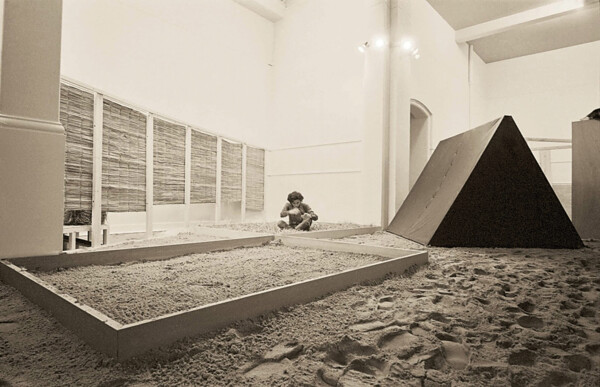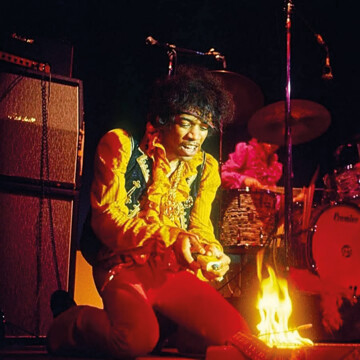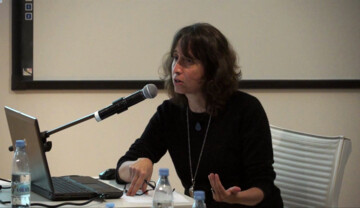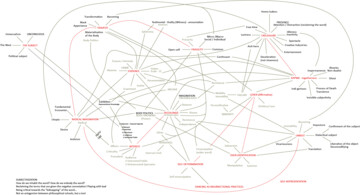Visiting all sorts of contemporary exhibitions, one can wonder if art is still able to transcend spectacularisation. The conviction that leisure provides clues to safeguard a sensory, experiential journey represents a skilful method, but what is to be done in practice with regard to this?

Figure 1: Hélio Oiticica, Eden, Whitechapel Art Gallery, 1969. Courtesy of César Oiticica Filho.
The proposition of creleasure arose in Hélio Oiticica’s exhibition at the Whitechapel Gallery in London (1969), as a development of the artist’s ongoing struggle against finished forms. (Figure 1) Combining a set of “penetrables” with different sensorial properties opened up for the participation of visitors (sand, leaves, straw, water), this historical show marks an undeniable inflection point. Oiticica realised there is no true life for art under the pressures of institutions or their artificial light. In fact, behaviour had already been a constituent part of one of his recent projects (Eden). As a reader of Herbert Marcuse, he introduced the notion of “non-repressive leisure” for the promotion of experimental proposals. In doing so, he achieved a wider understanding of artistic production and economy.
Notwithstanding the first negative resonance, how can one make the most of an inactivity? Can one conceive giving up producing and remaining a participating citizen, or at least still belonging to the collectivity as a full member?
Oiticica’s permanent drive to act in different directions, assuming social, psychological and ethical convictions, was made possible through a great emphasis on collective manifestations generated by music (samba, rock, rap) and → dance. Alongside arguments stressing the active role of the artist, there would also be room left for a very different activity, something like enjoying idleness. Questioning his own routine of producing objects to be exhibited, Oiticica gave his participatory program a key requirement for deceleration, allowing new assignments and powers to both parts of the process – proposers and participants.
In order to make creleasure a real proposition, a couple of specific aspects needed to be settled. Imagine a piece of clothing or an object as an extension of your skin – in this context, Oiticica has outlined the concept of “world-as-shelter”. And then imagine the fusion between object-subject and you get the fundamental dimension of body-wise: Jimi Hendrix setting his guitar on fire at Monterey Pop Festival in 1967. (Figure 2) Intrinsically articulated, these two concepts are the grounds for a space that is no neutral location, but an atmosphere, more like a climate or environment.
Figure 2: Bali Hai, Jimi Hendrix Sets Guitar on Fire at Monterey Pop Festival 1967, 40˝ video, 1967, posted on YouTube on 25 October 2011, https://www.youtube.com/watch?v=3U5dvC5qr6Y.
This very brief introduction is fundamental to grasp how an artistic program can turn its formal nature and nurture into political subjectivity. We are now the witnesses of a movement towards the opposite direction of the culture of laziness – the hyperactivity of artists, curators, and gallerists going crazy because of the hundreds of fairs and biennials happening simultaneously. One could almost argue that the everyday life of a successful artist is not too distant from that of any CEO working for a corporation. Not by accident, attention deficit disorder is a consequence of an inflated degree of activity.
This diagnosis is a decisive factor to be mentioned here. The underlying issue is to develop new strategies for slowing down. According to Felix Guattari’s comprehension of → the contemporary way of life, to be concerned with subjectivity is to reflect on a process that has jeopardised its exteriority at various levels, i.e. social, animal, vegetal, cosmic (or energetic).[1]
In a world overloaded with a multitude of tricks coming from the entertainment industries, is it still reasonable to stand up for (more) leisure?
In other words, to combine deceleration with urgency leads to one of the main philosophical issues of the digital era. As writers, we have all experienced that the final text is just the last and temporary version, or, let’s say, a virtual form until another one appears. Caught up in muddled projects endlessly being remodelled, this indefinite number of drafts only contributes to increase a rhetoric based on unsuccessful attempts. What does it mean that any representation is doomed to remain a work in progress, like a failure?
It is impossible to avoid here the remembrance of F. Scott Fitzgerald’s successive bankruptcies (The Crack-Up, 1945). Of course all life is a process of breaking down... It is less about voicing a nihilist drive than putting down the emphasis on productivity – “knowledge production” is the daily leitmotif of neoliberal systems. Paul Lafargue denounced the social and mental structures of → labour in his Le Droit à la paresse[2] (1880), a classic essay to understand the supreme values of the 19th century. Ultimately, Lafargue and Fitzgerald gather the main features of → the contemporary, albeit erroneous, notion of a → loser, whose disorderly condition originates from all sorts of inflations: unemployment rates, lack of integrity and ethical practices, bankruptcy proceedings.
Particular emphasis should be placed on the context of the Industrial Revolution here. Now since the Great Depression of 1929, at least once a decade the world has been undergoing a (new?) financial crisis, whose impacts are likely harmful to a growing city in peri-urban zones. In a society exposed to precarious employment, pleading for the “right of laziness” is a disturbing claim for both conservative and socialist regimes. Because it makes a minimal performance possible (a continuing operation or, as said by Fitzgerald, moving on is a necessary task, despite an immense drive to resign), the statement “I need to feel functional!” is a deep appeal for mercy from a depressed person asking for some medication to relieve intangible distress.
It is self-evident that the turn into our digital age has disseminated a collective machine addiction. If understood in the existential register of being body-wise, leisure is the opposite of entertainment. It is more like a temporary rest, given that the unbearable need to respond to the requests of others is getting stronger and stronger. Digital contacts on flat screens are actually the primal source of the rhythms inside any urban being. Totally internalised, mobile applications and portable devices are the uncanny wires of human brains.
One must assume that unfettered access to all virtual devices multiplies the experience of misery. Swinging in one of Oiticica’s famous hammocks is now impossible to imagine, what with users polishing their nails and plunged into a mood of distraction, as theorised by Walter Benjamin. In spite of navigating through the open arena of art, left as an active void, such users will be browsing a succession of links, checking online messages that drop at every minute. Inactivity as a creative space is thus perhaps the motto needed to preserve civilisation and freedom.





